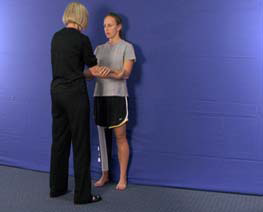AIM:
To train hip extension (in standing) in preparation for mid to end stance phase of walking
Rationale:
An important component of the stance phase of walking is hip extension. Patients must be able to contract the hip extensors from neutral to approximately 20° of hip extension. Task-related training is set up so the patient can practice with manual guidance from the therapist if necessary and/or support from the wall.
Equipment:
- Leg splint (if necessary)
- Stool
- Arm sling (if necessary)
Key Points:
- Patient is positioned in standing against wall with feet shoulder-width apart, toes pointing forward, trunk, hips and knees extended
- A splint may be placed on the patients affected leg to maintain knee in extension (if necessary)
- Patient extends hips by moving bottom forwards and off the wall
- Therapist is positioned in front of the patient and provides manual guidance at the arms
- Alternatively, therapist may sit to the side so that manual guidance may be provided to maintain affected hip and knee extension
- Encourage patient to maintain weight through the affected leg
- Ensure movement is in an appropriate range for the activity, ie, 0-20° of hip extension
Common Errors:
- Patient uses other muscle groups to assist the movement, eg, back extensors (lumbar lordosis increases)
Progression and Variety:
- Decrease/remove manual guidance
- Decrease/remove other forms of support, eg, leg splint
- Sustain muscle contraction
- Increase speed of movement
